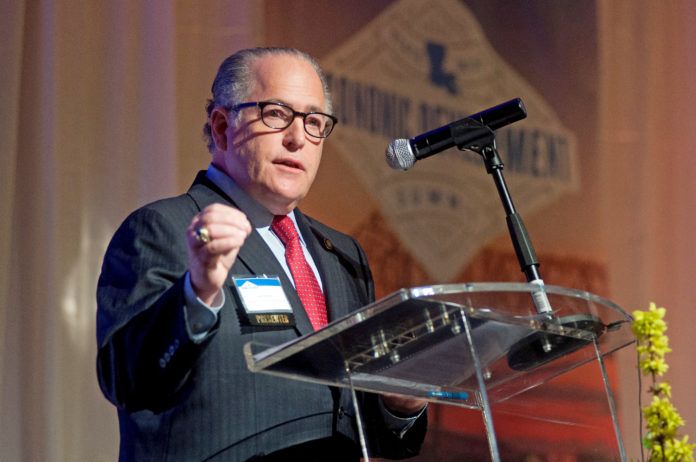Gov. John Bel Edwards’ new economic development chief, Don Pierson, credits his military background for fueling a deep belief in teamwork, planning and organization.
Pierson is a graduate of the United States Military Academy at West Point and served in the 82nd Airborne Division for five years before embarking on a career in economic development that has spanned nearly three decades.
Edwards’ three predecessors, Govs. Mike Foster, Kathleen Blanco and Bobby Jindal, each tapped Pierson for various positions in economic development. Most recently, he served under Jindal as assistant LED secretary.
Leading the charge for business recruitment and retention has its challenges in a state facing a $600 million budget shortfall in the next fiscal year, but Pierson says he is bullish about Louisiana, taking the long view and pointing to the state’s resources and assets, and its strength in sectors like chemical production, agriculture and timber products, aerospace, and technology.
We sat down with him in April to get a read on his priorities and his outlook.
Q. What has been your top priority so far?
A. To retain and grow the tremendous opportunities that have been afforded to us, and that calls for a lot of planning, teamwork and execution. The department has been very successful, but for projects that have been announced, those are just starting points, not finished points. It’s at this point in time that we put the workforce together, and it’s when engineering commences and when permitting processes get underway. So we have a great deal of important business to accomplish in order to fully realize the significant number of announcements and projects we have underway.
Q. You have said supporting small businesses is one of your main objectives as secretary. What is LED doing to accomplish this?
A. We have 11 small business development centers with free counseling that are strategically positioned throughout the state, often on four-year campuses. Even if you’re operating a successful small business, you can go to these centers and learn about putting together a business plan for a bank so you can, for example, grow additional market lines, a new location or new marketing to enhance your business. It’s important that small businesses are staying competitive. There’s no standing still in today’s economy, and Louisiana’s small businesses represent 80% of our jobs.
Q. How do Louisiana’s current fiscal challenges impact your job as the state’s top economic developer?
A. It’s an important endeavor right now to right-size our budget and to make sure that education, health care and transportation infrastructure needs are met. That backdrop makes economic development a bit more challenging in the short term, but most investments take the long view, and Louisiana is rich in assets, including our transportation infrastructure, deep water ports, highway and rail, natural gas and labor supply. We are well-positioned to attract a diverse array of business, and we’re particularly well-positioned as one anticipates the growth of the global economy as we become more reliant on moving products to developing nations. The long-term potential we have remains extraordinary.
Q. What about the downturn in oil commodity pricing?
A. Certainly, oil commodity pricing has been tough and is impacting our situation, but the silver lining is that we have available labor resources, and that can be important when trying to effect a project win. We have layoffs in the oil and gas sector in Lafayette and in the Houma-Thibodaux area, while in Lake Charles, we have $97 billion in announced projects, with $33 billion in projects under contract. Large projects also related to industrial construction are going on between Baton Rouge and New Orleans, including Shell’s major expansion and Monsanto’s billion-dollar project in Luling. The idea would be to transition some oil and gas workers into industrial construction.
Q. Manufacturing has been a bedrock sector for Louisiana. What are the current conditions for manufacturing?
A. The low price of oil is of great benefit to chemical production facilities because it represents a low feedstock and energy cost to run their facilities, so for those entities engaged in gas-to-liquids, liquefied natural gas, chemical production, fertilizers, plastics—they all have a favorable business environment and that’s why we’re seeing those plants run at record capacities and expanding into new markets. That side of manufacturing is going well.
In other sectors, oil commodity pricing is still causing significant challenges, and you’re seeing that in areas like steel, oil and gas, and other types of fabrication. So it’s a mixed market and one that we anticipate will change over time, as business cycles do. We’re very confident that oil and gas will be robust again in the not-too-distant future, but for the time being there are significant struggles in that sector.
Q. In recent years, Louisiana has improved its ranking in site selection, in its ability to attract national and international investment. What will it take to continue to attract new companies and sectors, and to convince resident companies to remain in Louisiana and expand?
A. One of the ways we do it is at the community level, trying to make sure our communities are well-prepared to compete for, and win, industrial and commercial opportunities. We conduct a nine-month leadership course where we deploy modules that help them focus on workforce development, site industrial development and other areas, so that, over time, they’re able to be better prepared [to compete.]
We also have a Certified Sites Program, where we take identified properties that are a great potential location for industry and do the necessary survey work and Phase One environmental review. And we ensure that the site is properly served by the utilities required by industry. If any of these areas don’t measure up, the community has the opportunity to do the forward planning to remedy the situation so we’re able to package the site as shovel-ready. It’s like a Good Housekeeping “seal of approval.”
We now have more than 65 of those sites registered across the state in 27 different parishes.
Q. A lot of attention is given to new wins, but how do you retain existing companies?
A. While we are aggressive in recruiting new businesses to our state, we’re also proud of our efforts to build on our existing business and industrial assets. In partnership with regional economic development organizations, we conduct 60 to 800 business visits annually. We start at the top with major economic driver companies to make sure we’re in close communication with them. These discussions are collected in a database so we can see trends, document concerns and make recommendations for improvement that help us keep pace on competitiveness.
There are two other really important outcomes as well, including getting ahead of disaster management and business disruption issues because we’re in touch with these companies. And we can often discover in these conversations if a business or [offsite headquarters] is contemplating expansion. When that happens, we can immediately go to work to build the case that Louisiana is the most robust opportunity for that expansion.
Q. What has to be in place to convince them?
A. It’s not something that just happens—it happens because of a number of factors, including low cost of business, utilities, logistics and deploying a skilled workforce efficiently and effectively to help the business accomplish the expansion. And that brings me to LED FastStart, which has been recognized as the No. 1 workforce program in the nation for the last six years.
Q. FastStart has clearly been a big factor in site selection. How will it continue to keep its edge?
A. We will work hard to maintain FastStart’s status, and we’re well aware that other states are going to be doing more in workforce training. But we believe we can outpace our competition because we’ve gained a lot of intellectual property about how to build even stronger relationships with educational institutions, both K-12 and higher education. We’ve found that we can lower the walls of silos and have more focused conversations about matching education with jobs. Those engagements will help us optimize the number of our graduates in Louisiana we’re moving into high-paying jobs.
Q. There have been a number of recent announcements. Tell us about those and what’s on the horizon.
A. Some of our recent announcements, including Shell’s $717 million expansion in Geismar, speak to our traditional strengths, but we’re also pleased to see success occurring in the forward-looking sectors of our economy like digital media with IBM and CenturyLink forging an important partnership in Monroe and with CSRA in cybersecurity and with other types of computer applications. We have the software company, CGI, in Lafayette, IBM in Baton Rouge and GE Capital in New Orleans. These are only the major names you hear about. There is a much larger array of smaller digital companies in those markets and in other markets in our state that are also meeting with success.
In addition to technology and software production, we’re seeing success in aerospace and aviation, and anticipate that’s another rich field for us. We see it in Continental Express Jet’s recent announcement of expansion in Shreveport. In Lafayette, you have Bell Helicopter, which announced last year its assembly of the 505 Jet Ranger. At Chennault in Lake Charles we have AAR, one of the leading maintenance repair operators in the world, and across the runway, Northrop Grumman is executing contracts for the U.S. Air Force. England Airpark is a new megasite designation. The aviation sector is on the grow in Baton Rouge, and right outside New Orleans at the Michoux Assembly Facility, NASA is constructing the Orion space capsule.
Q. So the strategy is to balance both continued growth in legacy sectors and push for growth in a variety of new sectors where recently we seem to be gaining traction?
A. Our challenge is to continue to manage those diverse elements in the economy, and to seek to position Louisiana workers to take advantage of the opportunities today in their communities, or in nearby communities. We want to do that in a way that, over time, we measure success by a greater number of people working in Louisiana than ever before, and those at work receiving higher wages than ever before.
Originally published in the second quarter 2016 edition of 10/12 Industry Report.









